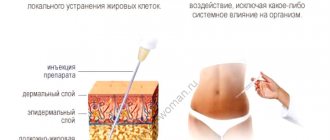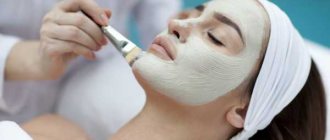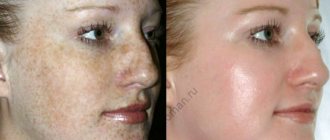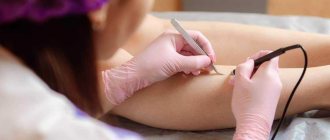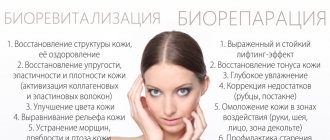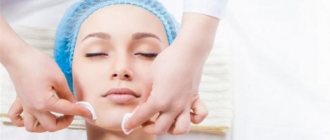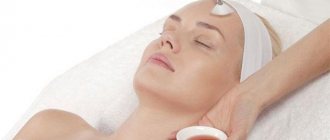What is the difference between peeling and scrub? Similarities Differences Composition Methods of using scrubs and peelings
Beautiful healthy skin is an indicator of the general condition of the body. In order to maintain its well-groomed appearance for a long time, it is necessary to regularly clean its surface from dead cells, dirt, dust, sweat, etc. There are scrubs and peelings for this. They stimulate cellular regeneration, improve blood microcirculation, and normalize the functioning of the sebaceous glands.
Let’s figure out what their main similarities and differences are, what their composition is and how to use them correctly.
What is the difference between them and which is better?
Scrubbing is a cosmetic procedure that removes dead cells, dirt and oil from the face by chemical or mechanical means. Removal occurs using solid particles. They are:
- natural – crushed fruit seeds or nut shells;
- artificial - included in special creams.
Peeling is a cosmetic procedure whose purpose is to remove the stratum corneum and prevent freckles, age spots and facial contamination. Its main components are fruit acids, which weaken the connection between skin cells and promote their accelerated exfoliation.
Similarities
Peels and scrubs have almost equally aggressive effects on the skin. The former cause her a chemical burn, which can be controlled, and the latter grind the skin with particles. Due to skin injury, cell renewal occurs.
Difference between procedures
Below you can find out how these facial procedures differ:
- It is advisable to use peelings from autumn to spring, and scrubs – all year round.
- The scrub can be done at home without harm to the skin using simple ingredients: coffee, sugar, salt, honey, etc.
- Peelings have a complex composition. When preparing, be sure to take into account every gram of component.
- Scrubs work better on the surface of rough skin.
- The results from home peels are less effective than from salon peels.
- The result after scrubbing the skin is visible immediately.
- Peels must be followed in a course, then the effect will last for a long time.
- You can make a scrub both on the face and on the scalp.
- Peels can be used on the hands, neck, décolleté and face.
We recommend: What is azelaine peeling and what are its features?
Indications and technique, side effects A cosmetologist will tell you briefly about the differences between scrub and peeling:
Compound
The composition of peelings and scrubs differs in that:
- the scrub consists of large solid particles and is a thick and viscous substance;
- The peeling contains tiny particles, and it itself is in the form of a liquid gel.
In addition, there are 2 main types of peelings:
- Enzymatic - enzymatic . The effect on the skin is carried out using special enzymes.
- Chemical . Their main component is various acids that activate skin cell renewal processes.
There are also 2 types of peelings:
- Hardware . It affects the skin using ultrasound, laser, high or low temperatures.
- Mechanical . Cleanses the face with abrasive elements.
The scrub contains particles that do not have such an aggressive effect on the epidermis. It may be based on:
- clay;
- gel;
- regular cream.
And abrasive elements can be:
- coffee;
- sea salt;
- grape seeds, etc.
Misconception #6. THE PRODUCTS DIFFER ONLY IN CONSISTENCY
Most often, women's portals state: peeling differs from scrub only in a “softer gel consistency.” The difference is found only in the absence of coarse particles of apricot kernels, crushed deer antlers and other wounding substances.
This interpretation is not entirely correct:
- HARDNESS IS DIFFERENT FOR ALL EXFOLIANTS , depending on the area of application: for the body or face;
- EXFOLIANTS CAN BE OF DIFFERENT CONSISTENS + generally DRY (brush, washcloth, mittens or socks) + LASER (when dead particles of the epidermis are pushed to the surface due to heating by a laser beam), etc.
We recommend: 5 recipes for PUMPKIN PEELING
Indications and contraindications
Indications for use of peeling:
- acne;
- post-acne;
- lumpy and uneven skin;
- sebaceous plugs;
- keratosis;
- increased fat content;
- dullness of the skin;
- sagging skin;
- wrinkles;
- chronic pathologies;
- dark spots.
Contraindications:
- very sensitive skin;
- Herpes virus;
- tattoos and a fresh tan;
- period of pregnancy and breastfeeding;
- the presence of moles, wounds, scratches, papillomas, warts on the skin.
Indications for scrubbing are:
- dark;
- dull complexion;
- enlarged and contaminated pores;
- comedones;
- flaky lips.
Contraindications to scrubbing are identical to contraindications to peeling and other cosmetic cleansing procedures.
Important ! These products should not be applied to or get into the eye area.
Execution Sequence
As you know, peeling with acids is quite traumatic, so during sessions you wait 14–21 days so that the skin can recover.
If your dermis tolerates exfoliation well, can you try combining peeling with scrubbing? Of course, yes, but only when you do superficial exfoliation. Stages of combined use:
- Steam your face, which will help open the pores.
- They start with a scrub. The face is washed with baby soap, and then a scrub is applied and a light massage is performed, avoiding the area around the eyes. After 2 minutes, wash off the product with warm water or wipe with a napkin.
- Gentle cosmetics are applied to the skin for superficial peeling (in no case with strong chemical peeling!). Wait a few minutes (the manufacturer always indicates the holding time on the packaging).
- If the scrub can be wiped off with a regular napkin, then the peeling suspension is washed off with plenty of water or soda solution.
Cosmetologist Rene Rouleau advises alternating both procedures, after consulting with a specialist. For example, on Wednesday and Saturday you can treat your skin with scrubbing in the shower, and on Monday treat it with a superficial peeling agent.
Important point: Scrubbing after deep chemical peeling is prohibited, because the skin has been burned. Your dermis should recover in 14–21 days. As soon as you see that the condition of the skin has returned to normal (at least a month after the session), you can start using scrubs at home.
Thus, what to choose: peeling or scrub is up to you. But if you really want to not only cleanse your pores, but also improve the condition of your dermis, make an appointment with a cosmetologist for chemical peeling. Although this procedure is not the cheapest, and has a number of contraindications, it not only removes dead skin cells, but also normalizes the functioning of the sebaceous glands, eliminates acne and minimizes wrinkles. If going to a specialist is alien to you, it is recommended to combine superficial peeling with scrubbing at home to enhance the cleansing effect.
Methods of application
The peeling procedure consists of three main stages:
- Preparation . Before applying the peeling product, clean your face with a cotton pad soaked in micellar water or makeup remover. Then wash your face using gel or foam.
- Application process . Apply the peeling composition to dry skin and leave for 5-10 minutes. Next, rinse with plain water.
- The final stage . Apply toner and moisturizer to clean, dry skin.
We recommend: Subtleties of pre-peel preparation of facial skin
It is better to use peeling in a course, the number of times depends on what result you want to get and where exactly you perform the procedure - at home or in the salon.
Scrubbing is also divided into several stages:
- Skin cleansing . It is necessary to cleanse your face with foam or makeup remover.
- Warming up . Using a cotton pad, napkin or towel, as well as boiling water, you need to steam your face before the procedure. This will open the pores and allow the scrub elements to penetrate deeper.
- Application . Using gentle massage movements, apply the scrub to the face and rub for 3 minutes.
- Excerpt . Then it is left for 5-10 minutes. This way, the active substances can saturate the epidermis with beneficial properties.
- Removal . The scrub is washed off with warm water.
- Completion . Apply the moisturizer you usually use.
Reference ! To get a noticeable effect, use the scrub in the evening.
Combining scrubs with facial peeling
Peeling is a procedure that causes less trauma to the skin, but it cannot be used too often. If the skin tolerates this procedure well, then cosmetologists recommend combining it with a scrub to ensure maximum care for the dermis. In order to cleanse and remove the superficial stratum corneum, a scrub is first used, and then peeling is used for a deep impact and activation of rejuvenation processes. Without pre-treatment with a scrub, the effect will not be effective enough.
Advantages and disadvantages
Peels and scrubs have many pros and cons, thanks to which you can understand whether this procedure is worth using or whether it is not suitable for you. Let's list the most basic ones.
Pros of scrubs:
- excellent against cellulite and sagging skin;
- stimulate microcirculation in cells;
- help remove excess fluid from the body;
- speed up metabolism;
- makes the skin softer, smoother and improves its color.
Minuses:
- hard particles injure the skin and lead to inflammation;
- before going out into the sun, due to recent scrubbing, you can get pigment spots;
- Constant scrubs can erase the top layer of the epidermis.
We recommend: What is mechanical peeling, why is it needed? Types, instructions and techniques for doing it at home
Peeling benefits:
- improvement of complexion and structure of the face;
- cleansing and narrowing pores;
- normalization of sebum production;
- renewal of tissues and cells;
- acne treatment.
Disadvantages of the procedure:
- complications may arise due to incorrectly selected components and acids;
- the effect will be noticeable only after several procedures or even a complex;
- partial dark spots may appear on light skin;
- light pigmentation is possible on dark skin;
- After the procedures, prolonged redness of the face is possible.
Misconception #4. BOTH ONLY EXFOLIATE THE TOP LAYER OF SKIN
The coverings of our face are completely renewed approximately once every 30 days.
For a child, it is “soft and silky” on its own, but for an adult, additional help is needed to get rid of unnecessary dead cells.
The scrub is only superficial, and peeling also includes:
| Median | Penetrates within the layers of the epidermis to the basement membrane: a framework of collagen and elastin |
| Deep | Renews at the level of the reticular, or reticular, layer of the dermis |
What should not be done after the procedures?
The cosmetologist who performed your facial cleansing procedure should explain what can and cannot be done after scrubbing or peeling. If you still don't know what is prohibited, read the following list:
- Do not use daily creams;
- you cannot wear makeup for several days after the procedure;
- if the epidermis peels off, do not remove the crusts yourself;
- Do not touch the treated area of the body; there is a possibility of causing a serious infection.
Tips from cosmetologists
In order not to injure the skin after peeling and scrubbing, cosmetologists advise you to remember and use a few simple rules.
After scrubbing:
- do not wash your face for 4-5 hours, wipe your face with tonics that do not contain alcohol;
- do not go to the bathhouse, sauna or swimming pool in the next week;
- Apply moisturizers at night.
After peeling:
- do not wash your face for 24 hours;
- do not visit solariums and beaches;
- use alcohol-free cosmetics;
- Before going outside, in warm weather, use sunscreen.
Scrub and peeling are interesting procedures for cleansing the face, differing in some properties. The result after them will remain effective only if they are performed correctly and efficiently.
Compound
Scrubs and peelings differ in composition. The first products are based on abrasive particles of sugar, salt, coffee beans, crushed nut shells and seeds, pearl powder, and synthetic granules. The product may contain cream, gel, oil, clay, dried plant extracts.
The composition of the second preparations differs in the content of tiny particles, acids, enzymes, plant and algae extracts. Exfoliating creams and solutions often contain vitamins, minerals, and coral powder. Alkaline peels contain calcium carbonate, while acid peels contain lactic, salicylic, glycolic, fruit and other acids. Enzyme peels include proteins of plant, animal or fungal origin. These ingredients trigger chemical processes in the skin.
